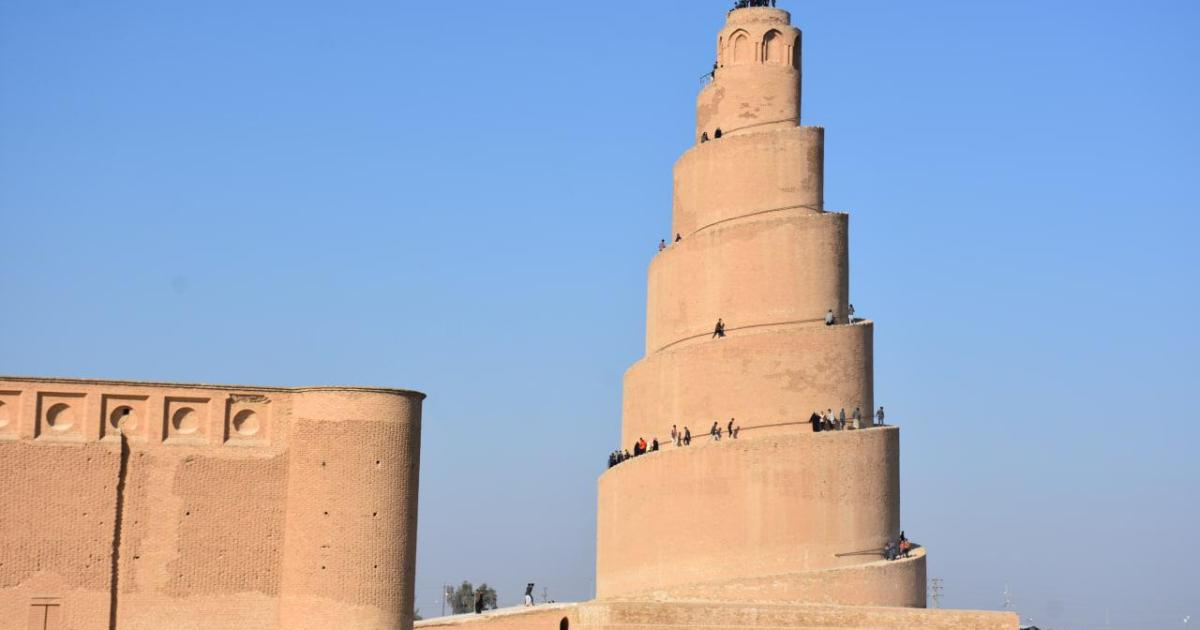The Great Mosque of Samarra and the Minaret of Malwiya are among the most prominent monuments of the Abbasid Caliph Al-Mutawakkil (Al-Jazeera)
Iraq is home to hundreds of historical mosques, which still stand tall despite the passage of time, and stand as a witness to the history of Islamic civilization in Mesopotamia and its never-ending legacy.
The Islamic conquest of Iraq began during the caliphate of Abu Bakr al-Siddiq, may God be pleased with him, while Basra was the first city established by Muslims in Iraq during the reign of Omar ibn al-Khattab, may God be pleased with him. It was planned by Utbah ibn Ghazwan in the year 14 or 15 AH, then Kufa was planned by it, which was planned by Saad. Bin Abi Waqqas in the year 17 AH. The Basra Mosque and the Kufa Mosque are considered the oldest mosques in Iraq.
Iraqi researcher and historian Ali Al-Nashmi says that building mosques in Iraq witnessed great interest during the rule of the Umayyad and Abbasid states, and that the mosque at that time became a center of public life, where people gathered to hear the state’s decisions and where Muslims’ money was kept.
Al-Nashmi explains, "Therefore, it played a major role in the life of the Islamic community and its religious, intellectual, and political renaissance. Most of the mosques were centers of cultural radiance, and scientific universities with full specializations, in which students received various sciences at the hands of scholars proficient in their specializations."
#Qena_infographic |
The mosques of #Iraq and its historical mosques...scientific edifices and centers of cultural radiation #Qena https://t.co/uG6c6aUyix pic.twitter.com/34MVNpckNw
- Qatar News Agency (@QatarNewsAgency) March 17, 2024
He pointed out that Baghdad, Kufa, Basra, and Mosul contributed effectively to building the language, and from there other linguistic schools splintered, and they were the first Islamic cities to teach pure sciences such as astronomy and chemistry in their mosques.
Baghdad
He continued, saying, "The capital, Baghdad, contains a large number of mosques and mosques, including 912 mosques in which Friday prayers are held, and 149 small mosques in which only the five daily prayers are held," indicating that the Caliphs Mosque in Baghdad, along with the Al-Mansour and Al-Rusafa mosques, are among the largest mosques in the historical city, which was Friday prayers were held there during the last four centuries of the Abbasid Caliphate.
The Iraqi historian recounts part of the history of the construction of the Al-Khulafa Mosque, saying: “The mosque was built in the third century AH during the time of the Caliph Al-Muktafi Billah, meaning that its lighthouse has been standing for more than 1,200 years, making it one of the oldest lighthouses in the world. The mosque also includes an eight-room prayer hall.” The shape is surmounted by a dome decorated with Kufic script, about 7 meters high, in addition to the basic height of the building, which is about 14 metres. There are also 3 corridors leading to the prayer hall.
Al-Nashmi added that the Baghdadis call the lighthouse of the Caliph Mosque “the lighthouse of Souq al-Ghazal,” in reference to the well-known popular market. The mosque was restored in the 1960s without harming the lighthouse, in order to preserve its archaeological value.
The Caliphs Mosque was built between the years (289-295 AH / 902-908 AD), and the traveler Ibn Battuta mentioned it when he visited Baghdad in the year 727 AH / 1327 AD.
The mosque’s minaret was the highest minaret from which Baghdad could be seen from its minaret. Its height was 35 metres. The minaret fell and the mosque was demolished in 670 AH/1271 AD, and they were rebuilt in 678 AH/1279 AD.
Samarra
One of the most famous mosques in Iraq is the Samarra Mosque, which is famous for its unique minaret. It was built during the reign of Caliph Al-Mutawakkil on God between the years 234 and 237 AH.
At its time, the mosque was the largest in the Islamic world, and it was one of the most impressive structures of influence during that era in the history of the Islamic nation. Its ruins can still be seen today with its Malawi minaret northwest of the current city of Samarra. It is considered the largest and most prominent remaining ruin of the buildings of the ancient city.
Samarra is considered one of the mothers of ancient Iraqi cities, and is still full of Islamic monuments. The city is located on the eastern bank of the Tigris River, about 118 kilometers north of the capital, Baghdad. It was built by the Abbasid Caliph Al-Mu'tasim Billah in the year (221 AH/835 AD), so it was the capital of the Abbasid Caliphate.
Also, the Al-Nouri Mosque in the city of Mosul, which is known as (the Great Mosque) for its capacity and the grandeur of its structure, is one of Iraq’s historical mosques. It is located on the right (western) coast of Mosul, and the area surrounding the mosque is called the Great Mosque District.
The mosque was built during the reign of Sultan Nour al-Din Mahmoud Zengi in the sixth century AH. It is the second mosque built in Mosul after the Umayyad Mosque. It was reconstructed several times, the last of which was in 1363 AH/1944 AD.
The mosque is famous for its minaret, angled towards the east, and it is the only part of the original building remaining in place.
Source: Al Jazeera + Qatar News Agency (QNA)

